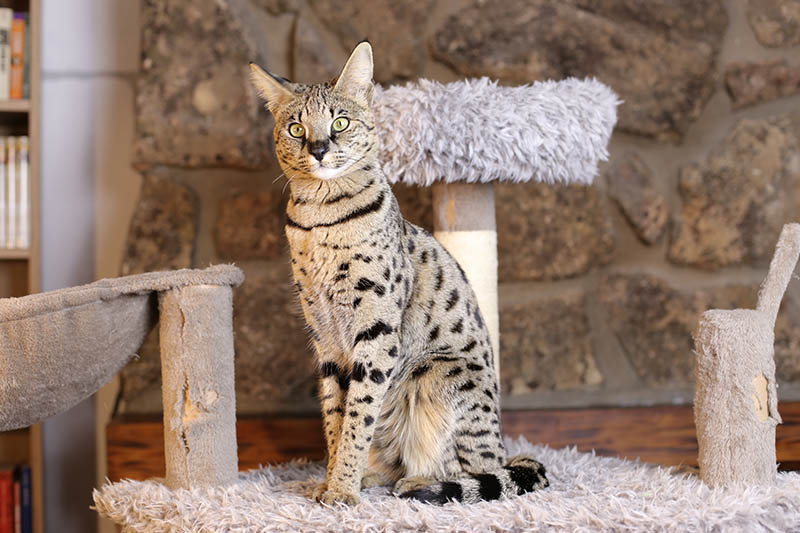From the tallest cat in the world to the longest, the heaviest to the kitty with the longest tail, we’ve put a list together of the biggest cats in the world.
If you appreciate cats as much as we do, then the chances are you like them all, from towering titans to teacup-sized fluffballs. Still, it’s fascinating to learn about all the remarkable record-breaking felines out there.
First up, it is Fenrir—the tallest cat in the world today!
The 7 Biggest Cats in the World
1. Fenrir – The Tallest Domestic Cat in the World (Living)
| Height | 18.83 inches |
| Breed | F2 Savannah |
Fenrir the Savannah cat currently holds the record for the tallest living cat in the world. Standing 18.83 inches tall, Fenrir has inherited his astonishing size from his grandfather, a Serval named Kongo. Servals are medium-sized African wild cats.
Savannah cats usually grow to between 14 and 17 inches tall. At nearly 2 inches taller, Fenrir dwarfs even his breed. According to his owner, Will, “Sometimes people see him and think he’s a small panther, a puma, or an ocelot.”
Fenrir is not the only record-breaker in his family. His brother Arcturus—who unfortunately died in a tragic house fire—holds the record for the tallest domestic cat ever.
2. Arcturus – The Tallest Domestic Cat (Ever)
| Height | 19.05 inches |
| Breed | F2 Savannah |
Arcturus Aldebaran Powers was officially recognized as the tallest cat in the world in November 2016. Born in 2015, Arcturus was an F2 Savannah, just like his full brother, Fenrir.
Unfortunately, this beautiful cat—who was known for his unusually calm behavior and his penchant for posing for photos—died in a tragic house fire that also took the life of Cygnus, the record holder for the cat with the longest tail.
3. Barivel – Longest Domestic Cat (Living)
| Length | 47.2 inches |
| Breed | Maine Coon |
When it comes to the longest domestic cat alive, Barivel from Italy was officially crowned in May 2018. Barivel, a quiet and shy Maine Coon, measures 47.2 inches in length, while the average domestic cat measures around 30 inches!
While Maine Coon cats are generally larger than the average domestic cat, Barivel is unusually large, even for a Maine Coon. That said, she’s not the longest cat ever. That record belongs to Mymains Stewart Gilligan.
4. Mymains – Longest Domestic Cat (Ever)
| Length | 48.5 inches |
| Breed | Maine Coon |
Mymains Stewart Gilligan, or Stewie for short, was a Maine Coon who measured a whopping 48.5 inches long in 2010. Although Stewie sadly lost his battle with cancer in 2013, he remains, to this day, the longest domestic cat ever.
Despite his humongous size, Stewie is said to have been a gentle giant. This cat wasn’t an ordinary housecat; he was a certified therapy animal who regularly visited a local senior center.
5. Cygnus – Longest Tail on a Domestic Cat
| Tail length | 17.58 inches |
| Breed | Maine Coon |
Cygnus Regulus Powers, a silver Maine Coon, holds the record for the longest tail on a domestic cat ever at 17.58 inches! The record for the longest tail on a domestic cat was previously held by Stewie, whose tail measured 16.34 inches.
In 2017, Cygnus was unfortunately killed in a tragic house fire that also took the life of his brother—and fellow record breaker—Arcturus, the Savannah cat.
6. Himmy – World’s Heaviest Cat
| Weight | 46.9 pounds |
| Breed | Tabby |
In 1986, Himmy the tabby from Australia was awarded the title of the world’s heaviest cat. According to the Guinness World Records, he weighed nearly 47 pounds and had to be transported by wheelbarrow. Unfortunately, any excess weight will be damaging to a cat’s health, and in Himmy’s case, his extreme obesity would have made life especially uncomfortable for him. Himmy died of respiratory failure aged just 10.
To discourage the deliberate overfeeding of cats, Guinness World Records discontinued the category in 1998.
7. Hercules – Largest Living Cat in the World
| Length | 131 inches |
| Weight | 922 pounds |
| Breed | Adult male Liger |
While they aren’t a domestic breed, we couldn’t help but list the biggest feline in the world. Ligers—the hybrid offspring of a tiger mother and a lion father are believed to be the biggest cat species on Earth.
Measuring 131 inches in length with a height of 49 inches at the shoulder and weighing 922 pounds, Hercules is about the same size as 46 average-size male Maine Coons. Hercules, who lives in Myrtle Beach Safari in South Carolina, is more than 20 years old now but still holds the record for the largest living cat in the world.
Conclusion
That concludes our list of the seven officially recognized largest cats in the world. From Hercules the humongous liger to Fenrir, the tallest cat in the world, these remarkable and majestic cats have all left an unforgettable impression on people’s hearts.
If you’re looking to bring home a large breed of domestic cats, fluffy Maine Coons are known for being gentle giants, while Savannah cats are muscular and beautiful. With the right amount of attention and training, these cats will reward you with love, loyalty, and purrfect companionship.
Featured Image Credit: AJR_photo, Shutterstock
Contents
- The 7 Biggest Cats in the World
- 1. Fenrir – The Tallest Domestic Cat in the World (Living)
- 2. Arcturus – The Tallest Domestic Cat (Ever)
- 3. Barivel – Longest Domestic Cat (Living)
- 4. Mymains – Longest Domestic Cat (Ever)
- 5. Cygnus – Longest Tail on a Domestic Cat
- 6. Himmy – World’s Heaviest Cat
- 7. Hercules – Largest Living Cat in the World
- Conclusion











